20 June 2012
Yesterday we drove up from Addis Ababa to Guassa – up and up and up. Up out of the crowded streets and diesel fumes of the city into the open country, up winding roads. The main road has been paved now and traffic moved quickly.

We started at 7:00, packing our luggage and all the supplies Tyler had bought in town: a storage tent with long metal poles (tied to the roof of the car), two mattresses, bags of food for us and the other people in camp. Tyler let me ride shotgun so I could enjoy the views that he knew well from previous visits; he sat in the rear passenger seat snugly surrounded by mattresses and supplies.
Then we drove to the transport operator’s house to pay him for this trip, my return on Saturday, and Tyler’s return in six weeks. We were supposed to bring up cylinders of propane gas as well, but the driver was worried that would make the load too heavy for the car to make it up the steep road into camp, especially now that the rains have started.
Some things that make Ethiopia seem really different from other parts of Africa:
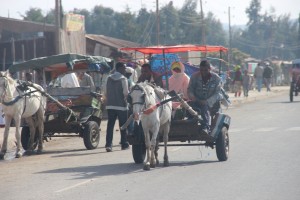
Horses. I don’t remember seeing anyone riding horses in East Africa. I’ve heard of horseback safaris in Kenya, but local people don’t have horses. But here we saw lots of horses: people riding thin little horses, the horses decorated with bright red tassels. Thin little horses pulling little carts with three or more people sitting across. I don’t know why more people don’t use horses in Africa – they seem much more economical than cars for subsistence farmers. Maybe disease is more of a problem for horses at lower elevations? Or they just never caught on?

Donkeys. Lots of donkeys, with huge loads strapped to their backs, wandering aimlessly about or being driven here or there. Many of them carried huge stacks of flattened, dried cow patties: fuel for the home fires. Loads that in East Africa would be piled up on a bicycle are carried by donkey here. Again, seems much more efficient to use pack animals. Some of the donkeys were very shaggy, which is very sensible given the cold here.
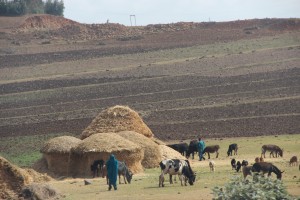
Cows. Most of the cows look similar to East African cows: long horns, big shoulder humps, usually reddish brown in color. But we passed a herd that looked like Wisconsin dairy cattle: white and black cows grazing in an open field.
On the road we sometimes passed the whole family herd on the move: horses, sheep, goats, and cattle all traveling together with the men, women and children herding them along, hitting them with sticks to get them to move away from oncoming cars.
The higher we climbed, the more fabric people wore wrapped around themselves: white cotton drapes with colorful trim at one end, worn wrapped around the shoulders, and sometimes wound around the head as a turban. Higher up people wore wool blankets over their shoulders. Starting to think I should have packed more winter gear…
The paved road, like many others in Africa, was built by the Chinese. I suppose much (if not most) of international aid is rather selfishly motivated. Much of American and European international aid seems directed to projects that make donors feel better about themselves, or to promote things they happen to care about, such as conserving wildlife. I suppose Chinese aid is just as selfishly motivated as Western aid, but roads at least seem a particularly useful, practical sort of aid. Road improvements make life easier in all sorts of ways for people. Though of course faster roads lead to more deaths, not just of people, but of gelada monkeys, Ethiopian wolves, and other wildlife.
Along the way, we passed cars and trucks in various stages of break-down and disaster. One truck with two trailers hung from a bridge, having plunged off the side of the road.
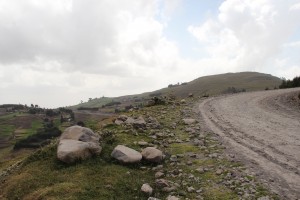
About halfway to Guassa, in terms of distance, we left the main road and took an unpaved little branch road that climbed steeply up into the hills. The car soon broke down. While the driver tinkered with the engine, Tyler showed me the plants growing alongside the road: lots of thyme, mint, dandelions, and various yellow, purple and red flowers, including red-hot pokers. Thyme grows all over Guassa.
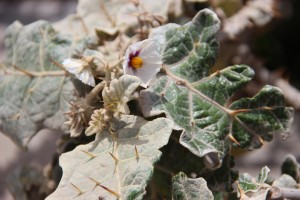
“That’s the scariest plant I’ve ever seen,” Tyler said, pointing to a plant that had inch-long thorns growing right from its leaves.
We shared a Snickers bar (our first food of the day, since the hotel doesn’t serve breakfast until 8:00) and some water. The road had already climbed so far above the paved road winding below that trucks looked like toys.
The driver got the engine going again, and we climbed into the car, driving higher and higher. We passed through forests of Eucalyptus trees, plantations clinging to steep hillsides.
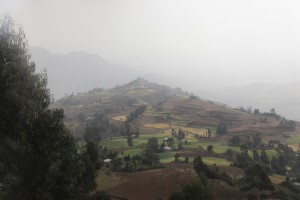
We climbed up high enough to see down into the Rift Valley, and what had seemed like amazing views before now seemed barely worthy of notice. Even with the dust and late dry season haze in the air, the valley floor seemed impossibly far away. Valley doesn’t even seem the right word for it — a valley is gentle and pleasant. This is more like a canyon, a chasm, a rent in the crust of the earth. This is what the view from Gombe would look like if someone pulled the plug on Lake Tanganyika.
Despite the views, lulled by a gentle rain and the long drive and jet lag, I dozed off.
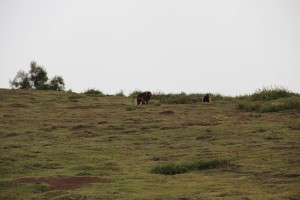
Sometime later, I woke up, hearing Tyler calling out that there were geladas ahead. We stopped and looked out the window to see a small herd of monkeys foraging in the grass near a cell phone tower. I took pictures, excited to see geladas for the first time. Tyler kept his amusement to himself, knowing that these views of distant, shy monkeys were nothing compared to what we would see of the research monkeys.
Finally, after hours of driving through landscape dominated by human activities — farms, fields, houses, tree plantations — we reached the Guassa: a vast, open country of hills covered by grass, flowers, herbs, and strange Afro-montane plants like giant lobelias.
Guassa is the local word for the kind of grass used for thatching roofs. For the past 400 years, the local people have protected this land in order to ensure a supply of thatching. In doing so, they also conserved a rare patch of natural habitat, and some of the creatures that only live here, in the Abyssinian Highlands: gelada monkeys, Ethiopian wolves, and many other endemic species.
We passed the Wolf Lodge, where the few tourists that make it up this way stay, and where the Frankfurt Zoological Society supports the study and conservation of the Ethiopian wolves. A herd of gelada monkeys scrambled up the cliff near the lodge. Tyler thought the researchers must be nearby but we didn’t see them. We continued on towards camp.
The road wound on and on, up into the hills. Tyler called for the driver to stop, then got out and scouted around until he found the faint track that led away from the main road towards camp. We drove up this steep, rocky track, until we could see camp emerging, a scattering of tents nestled at the head of a broad valley. This was where Peter Fashing and Nga Nguyen have been studying gelada monkeys since 2005. Tyler spent 13 months working as a volunteer on their study before starting graduate school at Minnesota, and now he was back to start his PhD research.
The two men in camp, Shoa and Bedulu, welcomed us. They greeted Tyler especially warmly, clearly very happy to see him again. Speaking Amharic, they told Tyler that the others were still out in the field. They helped unload the car. We thanked the driver, confirmed that someone would be back to pick me up on Saturday, then watched him drive away. An augur buzzard hovered over the edge of the cliff above camp, perfectly still, like a kite, holding steady in the strong wind blowing up from the valley far below. The air smelled of thyme, and rain.

